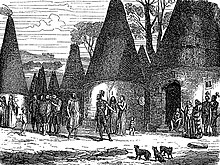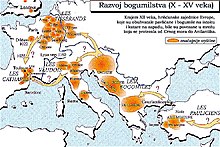| Part of a series on |
| Slavery |
|---|
 |



The Balkan slave trade was the trade in slaves from the Balkans via Venetian slave traders across the Adriatic and Aegean Seas to Italy, Spain and the Islamic Middle East, from the 7th-century Early Middle Ages until the mid-15th century. It was one of the routes of the Venetian slave trade.
The trade rested on the fact that the Balkans was a religious border zone, which was significant in the middle ages, when religion was the determining factor on who was viewed as a legitimate target of enslavement. The Balkans was Pagan territory long in to the middle ages. After it had converted to Christianity by the 11th-century, it was Orthodox Christianity and Bogomilism, which maintained its status as a religious border zone to the rest of then Catholic Europe. The slave trade of first Pagan and then Orthodox and Bogomile Christian Slavs were exported to Italy, Spain and Portugal in Southern Europe, but the major part of the export went to the Muslim Middle East.
The Balkan slave trade was one of the main routes of European Saqaliba-slaves to the Islamic Middle East, alongside the Prague slave trade in the West, and the Black Sea slave trade, the Khazar slave trade and the Bukhara slave trade in the East. It was a major contributor of mamluk slave soldiers to the Mamluk Sultanate of Egypt. The Balkan slave trade contributed to the establishment of the Republic of Venice as a prosperous trading empire in the Mediterranean Sea in the early middle ages.
In the 15th-century, the Balkan slave trade was closed of from Europe due to the Muslim Ottoman conquest of the Balkans, and consequently integrated to the Ottoman slave trade. The end of the Balkan slave trade's supply of slaves to Spain and Portugal contributed to the establishment of the Atlantic slave trade, when there was a demand of slaves to the new Spanish colonies of the New World, and the old Balkans slave supply source had to be replaced by a new source of non-Catholic slaves.
History
Background
During the Middle Ages, informal slave zones were formed alongside religious borders. Both Christians and Muslims banned the enslavement of people of their own faith, but both approved of the enslavement of people of a different faith. [1]
The slave trade thus organized alongside religious principles. While Christians did not enslave Christians, and Muslims did not enslave Muslims, both did allow the enslavement of people they regarded to be heretics, which allowed Catholic Christians to enslave Orthodox Christians, and Sunni Muslims to enslave Shia Muslims. [2]
The slave trade was founded upon the fact that the Balkans was a religious border zone between at first pagan and Christian, and later Catholic and Orthodox Christian lands. Since the custom at the time did not approve of enslaving people of the same religion, this made the Balkans a supply of slaves for both Christian and Muslim lands. Another factor was the fact that the Balkans was for a long time politically decentralized and unstable, and was in the early middle ages known as the Sclaveni or Slav lands. These two factors in combination made the Balkans a fertile target for slave trade, when war captives were sold by their enemies to Venetian slave traders at the coasts.
The most targeted category of the slave trade were the Bosnians, since they were adherents of Bogomilism, a faith which was not acknowledged as Christianity and therefore made them legitimate targets of slavery in Catholic as well as Orthodox Europe. [3]
Slave market
The Balkan slave trade was, alongside the Black Sea slave trade, one of the two main slave supply sources of future Mamluk soldiers to the Mamluk Sultanate in Egypt. [4] A smaller number of slaves were sold in Italy and Spain as enslaved domestic servants, called ancillae.
The end
The Venetian slave trade from the Balkans gradually ended in parallel with the conquest of the Balkans by the Ottoman Empire during the 15th century. The slave trade from the Balkans was ended as a separate slave trade and was overtaken by the Ottomans and incorporated into the Ottoman slave trade, [5] which in the Balkans was connected to the Crimean slave trade.
Venetian slave traders were not able to compete with Ottoman-Crimean competition. After this, they acquired a smaller number of slaves from Ottoman slave traders via the Trans-Saharan slave trade. The Venetian slave trade was however soon supplanted in Europe by the Atlantic slave trade of the 16th century.
See also
References
- ^ Slavery in the Black Sea Region, C.900–1900: Forms of Unfreedom at the Intersection Between Christianity and Islam. (2021). Nederländerna: Brill. 5
- ^ Korpela, J. (2018). Slaves from the North: Finns and Karelians in the East European Slave Trade, 900–1600. Nederländerna: Brill. 242
- ^ Omerovic, Asmin. Between Islam, Christianity, and Bogomil Heresy: The Slave Trade in the Bosnian Slaving Zone, 1280–1464
- ^ The Cambridge World History of Slavery: Volume 2, AD 500–AD 1420. (2021). (n.p.): Cambridge University Press. pp. 117–120
- ^ The Cambridge World History of Slavery: Volume 2, AD 500–AD 1420. (2021). (n.p.): Cambridge University Press. 117-120
You can help expand this article with text translated from
the corresponding article in Swedish. (October 2023) Click [show] for important translation instructions.
|
- 7th-century establishments
- European slave trade
- Asian slave trade
- Slavery in Asia
- Slavery in Europe
- 15th-century disestablishments
- Forced migration
- History of the Adriatic Sea
- Anti-white racism
- Trade routes
- Racism in Asia
- Slave trade
- History of the Balkans
- Mamluks
- Republic of Venice
- Economy of the Republic of Venice
- Slavery in the Byzantine Empire
- Italian slave trade
| Part of a series on |
| Slavery |
|---|
 |



The Balkan slave trade was the trade in slaves from the Balkans via Venetian slave traders across the Adriatic and Aegean Seas to Italy, Spain and the Islamic Middle East, from the 7th-century Early Middle Ages until the mid-15th century. It was one of the routes of the Venetian slave trade.
The trade rested on the fact that the Balkans was a religious border zone, which was significant in the middle ages, when religion was the determining factor on who was viewed as a legitimate target of enslavement. The Balkans was Pagan territory long in to the middle ages. After it had converted to Christianity by the 11th-century, it was Orthodox Christianity and Bogomilism, which maintained its status as a religious border zone to the rest of then Catholic Europe. The slave trade of first Pagan and then Orthodox and Bogomile Christian Slavs were exported to Italy, Spain and Portugal in Southern Europe, but the major part of the export went to the Muslim Middle East.
The Balkan slave trade was one of the main routes of European Saqaliba-slaves to the Islamic Middle East, alongside the Prague slave trade in the West, and the Black Sea slave trade, the Khazar slave trade and the Bukhara slave trade in the East. It was a major contributor of mamluk slave soldiers to the Mamluk Sultanate of Egypt. The Balkan slave trade contributed to the establishment of the Republic of Venice as a prosperous trading empire in the Mediterranean Sea in the early middle ages.
In the 15th-century, the Balkan slave trade was closed of from Europe due to the Muslim Ottoman conquest of the Balkans, and consequently integrated to the Ottoman slave trade. The end of the Balkan slave trade's supply of slaves to Spain and Portugal contributed to the establishment of the Atlantic slave trade, when there was a demand of slaves to the new Spanish colonies of the New World, and the old Balkans slave supply source had to be replaced by a new source of non-Catholic slaves.
History
Background
During the Middle Ages, informal slave zones were formed alongside religious borders. Both Christians and Muslims banned the enslavement of people of their own faith, but both approved of the enslavement of people of a different faith. [1]
The slave trade thus organized alongside religious principles. While Christians did not enslave Christians, and Muslims did not enslave Muslims, both did allow the enslavement of people they regarded to be heretics, which allowed Catholic Christians to enslave Orthodox Christians, and Sunni Muslims to enslave Shia Muslims. [2]
The slave trade was founded upon the fact that the Balkans was a religious border zone between at first pagan and Christian, and later Catholic and Orthodox Christian lands. Since the custom at the time did not approve of enslaving people of the same religion, this made the Balkans a supply of slaves for both Christian and Muslim lands. Another factor was the fact that the Balkans was for a long time politically decentralized and unstable, and was in the early middle ages known as the Sclaveni or Slav lands. These two factors in combination made the Balkans a fertile target for slave trade, when war captives were sold by their enemies to Venetian slave traders at the coasts.
The most targeted category of the slave trade were the Bosnians, since they were adherents of Bogomilism, a faith which was not acknowledged as Christianity and therefore made them legitimate targets of slavery in Catholic as well as Orthodox Europe. [3]
Slave market
The Balkan slave trade was, alongside the Black Sea slave trade, one of the two main slave supply sources of future Mamluk soldiers to the Mamluk Sultanate in Egypt. [4] A smaller number of slaves were sold in Italy and Spain as enslaved domestic servants, called ancillae.
The end
The Venetian slave trade from the Balkans gradually ended in parallel with the conquest of the Balkans by the Ottoman Empire during the 15th century. The slave trade from the Balkans was ended as a separate slave trade and was overtaken by the Ottomans and incorporated into the Ottoman slave trade, [5] which in the Balkans was connected to the Crimean slave trade.
Venetian slave traders were not able to compete with Ottoman-Crimean competition. After this, they acquired a smaller number of slaves from Ottoman slave traders via the Trans-Saharan slave trade. The Venetian slave trade was however soon supplanted in Europe by the Atlantic slave trade of the 16th century.
See also
References
- ^ Slavery in the Black Sea Region, C.900–1900: Forms of Unfreedom at the Intersection Between Christianity and Islam. (2021). Nederländerna: Brill. 5
- ^ Korpela, J. (2018). Slaves from the North: Finns and Karelians in the East European Slave Trade, 900–1600. Nederländerna: Brill. 242
- ^ Omerovic, Asmin. Between Islam, Christianity, and Bogomil Heresy: The Slave Trade in the Bosnian Slaving Zone, 1280–1464
- ^ The Cambridge World History of Slavery: Volume 2, AD 500–AD 1420. (2021). (n.p.): Cambridge University Press. pp. 117–120
- ^ The Cambridge World History of Slavery: Volume 2, AD 500–AD 1420. (2021). (n.p.): Cambridge University Press. 117-120
You can help expand this article with text translated from
the corresponding article in Swedish. (October 2023) Click [show] for important translation instructions.
|
- 7th-century establishments
- European slave trade
- Asian slave trade
- Slavery in Asia
- Slavery in Europe
- 15th-century disestablishments
- Forced migration
- History of the Adriatic Sea
- Anti-white racism
- Trade routes
- Racism in Asia
- Slave trade
- History of the Balkans
- Mamluks
- Republic of Venice
- Economy of the Republic of Venice
- Slavery in the Byzantine Empire
- Italian slave trade